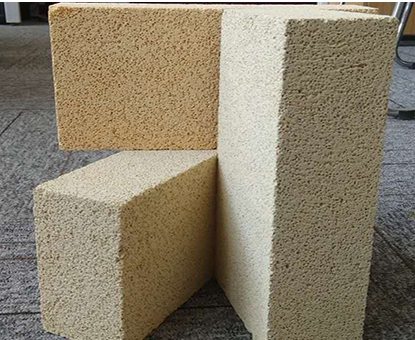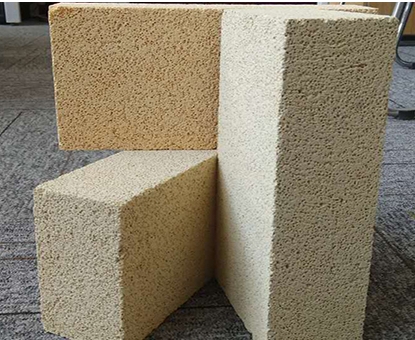- 17
- Oct
Ytelsen og egenskapene til ildfaste murstein i zirkoniumkorund
Ytelsen og egenskapene til ildfaste murstein i zirkoniumkorund

Zirkonium korund ildfaste murstein are made from industrial alumina and zircon sand. According to the manufacturing process, zirconium corundum refractory bricks can be divided into fused zirconium corundum bricks and sintered zirconium corundum bricks.
Henan ildfast mursteinprodusent, ildfast ballprodusent, lett isolasjonsstein, Zhengzhou Huaxin High Temperature Material Co., Ltd.
Fused zirconium corundum brick is commonly called white iron brick, also known as corundum clinoptilolite brick. The main chemical composition is 350%~70% Al2O, 220%~40% ZrO, and the rest is SiO2. The main mineral components are zircon (ZrO2), corundum (α-Al2O3) and glass phase. Zircon crystals form the skeleton of the brick. Zirconia has a high melting point (2715°C) and good chemical stability. Zircon is very corrosive to acidic and alkaline media, especially to molten glass.
Fused zirconium corundum bricks are used in glass furnaces and other industrial furnaces. The glass melting furnace components used in the glass melting furnace include upper pool wall, small furnace flat arch, small furnace pier, tongue arch and breast wall. The following issues should be paid attention to in the use of fused zirconia corundum bricks.
① Irregular changes in thermal expansion. The expansion curve of the fused zirconia corundum brick shows an abnormal section near 1000 ℃. Reversible changes occur inside the Zr02 crystal, and the volume changes greatly. Therefore, bricks containing ZrO2 should not be used in places where the temperature fluctuates sharply around 1000°C. In the oven, the temperature change between 900~1150℃ should not be too large, generally should not exceed 15℃/h, and the temperature should be raised steadily. Some places should be protected from cold wind, and other bricks should be used to prevent them from cracking.
②Krymping. I hellingsprosessen vises ofte krympingshull, tegllegemet har mange porer, og kompaktheten er dårlig. Derfor, når veggen i glasssmeltebassenget er konstruert, vil krympekaviteten utvikle seg i retning av ovnen. Hvis porten vender utover, når mursteinslegemet eroderes til et veldig tynt lag, vil det forårsake lekkasjer av glass. Den brukes i ovnens øvre flammerom, med lang levetid, og det er ikke noe problem med rømming av glassvæske. Derfor brukes støpeporten utover for å forlenge levetiden.
③ Eutectic. When the fused zirconia corundum brick is in contact with the clay brick, eutectic will appear at 1300℃. Therefore, when choosing refractory materials, serious eutectic phenomena of the two materials should be avoided.
Sintered zirconium corundum brick is also called ceramic bonded aluminum silicon zirconium brick. Compared with fused zirconium corundum bricks, sintered zirconium corundum bricks have similar chemical composition, but have the advantages of no carbon, low glass phase content, uniform structure, no shrinkage, good thermal shock stability, corrosion resistance, etc.
Ytelsen og egenskapene til ildfaste murstein i zirkoniumkorund

Zirconium corundum refractory bricks are made from industrial alumina and zircon sand. According to the manufacturing process, zirconium corundum refractory bricks can be divided into fused zirconium corundum bricks and sintered zirconium corundum bricks.
Henan ildfast mursteinprodusent, ildfast ballprodusent, lett isolasjonsstein, Zhengzhou Huaxin High Temperature Material Co., Ltd.
Fused zirconium corundum brick is commonly called white iron brick, also known as corundum clinoptilolite brick. The main chemical composition is 350%~70% Al2O, 220%~40% ZrO, and the rest is SiO2. The main mineral components are zircon (ZrO2), corundum (α-Al2O3) and glass phase. Zircon crystals form the skeleton of the brick. Zirconia has a high melting point (2715°C) and good chemical stability. Zircon is very corrosive to acidic and alkaline media, especially to molten glass.
Fused zirconium corundum bricks are used in glass furnaces and other industrial furnaces. The glass melting furnace components used in the glass melting furnace include upper pool wall, small furnace flat arch, small furnace pier, tongue arch and breast wall. The following issues should be paid attention to in the use of fused zirconia corundum bricks.
① Irregular changes in thermal expansion. The expansion curve of the fused zirconia corundum brick shows an abnormal section near 1000 ℃. Reversible changes occur inside the Zr02 crystal, and the volume changes greatly. Therefore, bricks containing ZrO2 should not be used in places where the temperature fluctuates sharply around 1000°C. In the oven, the temperature change between 900~1150℃ should not be too large, generally should not exceed 15℃/h, and the temperature should be raised steadily. Some places should be protected from cold wind, and other bricks should be used to prevent them from cracking.
②Krymping. I hellingsprosessen vises ofte krympingshull, tegllegemet har mange porer, og kompaktheten er dårlig. Derfor, når veggen i glasssmeltebassenget er konstruert, vil krympekaviteten utvikle seg i retning av ovnen. Hvis porten vender utover, når mursteinslegemet eroderes til et veldig tynt lag, vil det forårsake lekkasjer av glass. Den brukes i ovnens øvre flammerom, med lang levetid, og det er ikke noe problem med rømming av glassvæske. Derfor brukes støpeporten utover for å forlenge levetiden.
③ Eutectic. When the fused zirconia corundum brick is in contact with the clay brick, eutectic will appear at 1300℃. Therefore, when choosing refractory materials, serious eutectic phenomena of the two materials should be avoided.
Sintered zirconium corundum brick is also called ceramic bonded aluminum silicon zirconium brick. Compared with fused zirconium corundum bricks, sintered zirconium corundum bricks have similar chemical composition, but have the advantages of no carbon, low glass phase content, uniform structure, no shrinkage, good thermal shock stability, corrosion resistance, etc.
